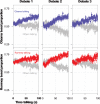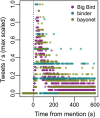Timescales of massive human entrainment
- PMID: 25880357
- PMCID: PMC4400172
- DOI: 10.1371/journal.pone.0122742
Timescales of massive human entrainment
Abstract
The past two decades have seen an upsurge of interest in the collective behaviors of complex systems composed of many agents entrained to each other and to external events. In this paper, we extend the concept of entrainment to the dynamics of human collective attention. We conducted a detailed investigation of the unfolding of human entrainment--as expressed by the content and patterns of hundreds of thousands of messages on Twitter--during the 2012 US presidential debates. By time-locking these data sources, we quantify the impact of the unfolding debate on human attention at three time scales. We show that collective social behavior covaries second-by-second to the interactional dynamics of the debates: A candidate speaking induces rapid increases in mentions of his name on social media and decreases in mentions of the other candidate. Moreover, interruptions by an interlocutor increase the attention received. We also highlight a distinct time scale for the impact of salient content during the debates: Across well-known remarks in each debate, mentions in social media start within 5-10 seconds after it occurs; peak at approximately one minute; and slowly decay in a consistent fashion across well-known events during the debates. Finally, we show that public attention after an initial burst slowly decays through the course of the debates. Thus we demonstrate that large-scale human entrainment may hold across a number of distinct scales, in an exquisitely time-locked fashion. The methods and results pave the way for careful study of the dynamics and mechanisms of large-scale human entrainment.
Conflict of interest statement
Figures







References
-
- Strogatz SH, Stewart I. Coupled oscillators and biological synchronization. Sci Am. 1993;269(6):102–9. Epub 1993/12/01. . - PubMed
-
- Mirollo RE, Strogatz SH. Synchronization of Pulse-Coupled Biological Oscillators. Siam J Appl Math. 1990;50(6):1645–62. 10.1137/0150098 . - DOI
-
- Pikovsky A, Rosenblum M, Kurths J. Synchronization: a universal concept in nonlinear sciences Cambridge: Cambridge University Press; 2001. xix, 411 p. p.
-
- Ancona D, Chong C-L. Entrainment: Pace, cycle, and rhythm in organizational behavior. Research in organizational behavior. 1996;18:251–84.
Publication types
MeSH terms
LinkOut - more resources
Full Text Sources
Other Literature Sources
Miscellaneous

